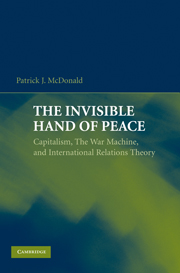Book contents
- Frontmatter
- Contents
- List of Tables
- Acknowledgments
- 1 American Grand Strategy and the Liberal Peace
- 2 Liberal International Relations Theory on War
- 3 Releasing the Invisible Hand
- 4 Liberal Economic Institutions and Peace in the Twentieth Century
- 5 Free Trade and Peace in the First Era of Globalization
- 6 From Rivalry to Friendship
- 7 The Achilles' Heel of Liberal International Relations Theory?
- 8 Peace Across the Taiwan Strait?
- 9 The Invisible Hand or the Ballot Box?
- 10 Capitalism and America's Peaceful Market Power
- References
- Index
1 - American Grand Strategy and the Liberal Peace
Published online by Cambridge University Press: 05 June 2012
- Frontmatter
- Contents
- List of Tables
- Acknowledgments
- 1 American Grand Strategy and the Liberal Peace
- 2 Liberal International Relations Theory on War
- 3 Releasing the Invisible Hand
- 4 Liberal Economic Institutions and Peace in the Twentieth Century
- 5 Free Trade and Peace in the First Era of Globalization
- 6 From Rivalry to Friendship
- 7 The Achilles' Heel of Liberal International Relations Theory?
- 8 Peace Across the Taiwan Strait?
- 9 The Invisible Hand or the Ballot Box?
- 10 Capitalism and America's Peaceful Market Power
- References
- Index
Summary
The United States has a long history of responding to strategic challenges and opportunities by promoting the spread of its own political and economic institutions abroad. Rooted firmly in a political culture defined by its attachment to individual freedom, this penchant often manifests itself in foreign policies supporting democratic transitions and economic liberalization around the world. Democracy and trade are trumpeted for two key reasons: states that possess liberal political and economic institutions do not go to war with each other, and they also tend to share common national interests. As democracy and commerce proliferate around the world, the United States should face fewer enemies while cultivating more political allies.
Many American political leaders over the past two centuries have reaffirmed these principles. Outlining the benefits of annexing Texas in his inaugural address, President Polk (1845) noted, “Foreign Powers do not seem to appreciate the true character of our Government … To enlarge its limits is to extend the dominions of peace over additional territories and increasing millions … While the Chief Magistrate and the popular branch of Congress are elected for short terms by the suffrages of those millions who must in their own persons bear all the burdens and miseries of war, our Government can not be otherwise than pacific.” At the Paris Peace Conference of 1919, Woodrow Wilson launched a bold and revolutionary plan to end balance-of-power politics that seemed to lead to war by creating a democratic global political order.
- Type
- Chapter
- Information
- The Invisible Hand of PeaceCapitalism, the War Machine, and International Relations Theory, pp. 1 - 22Publisher: Cambridge University PressPrint publication year: 2009



